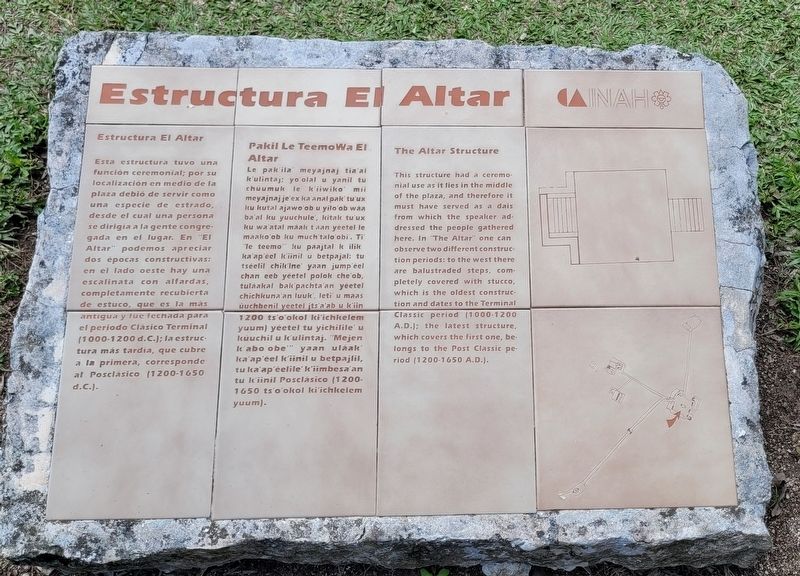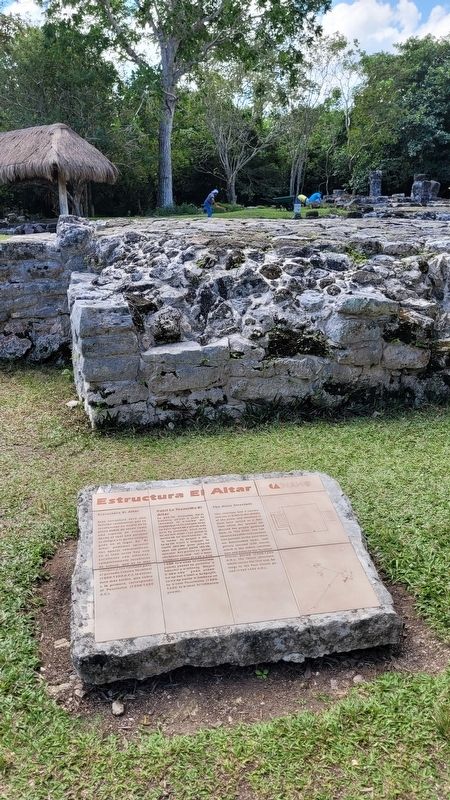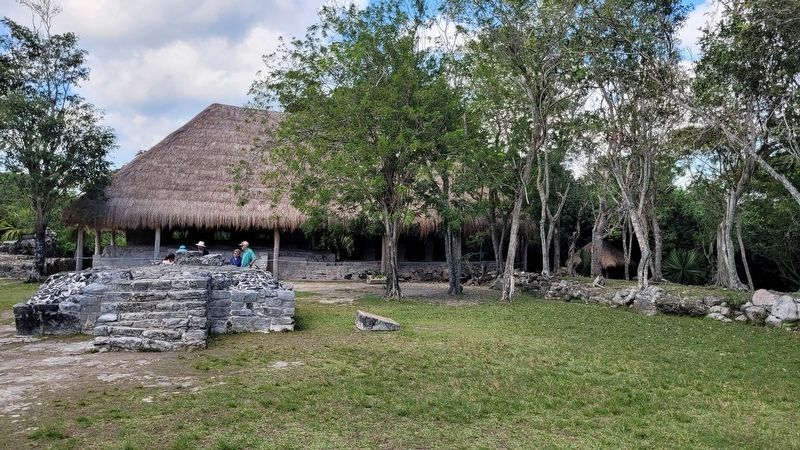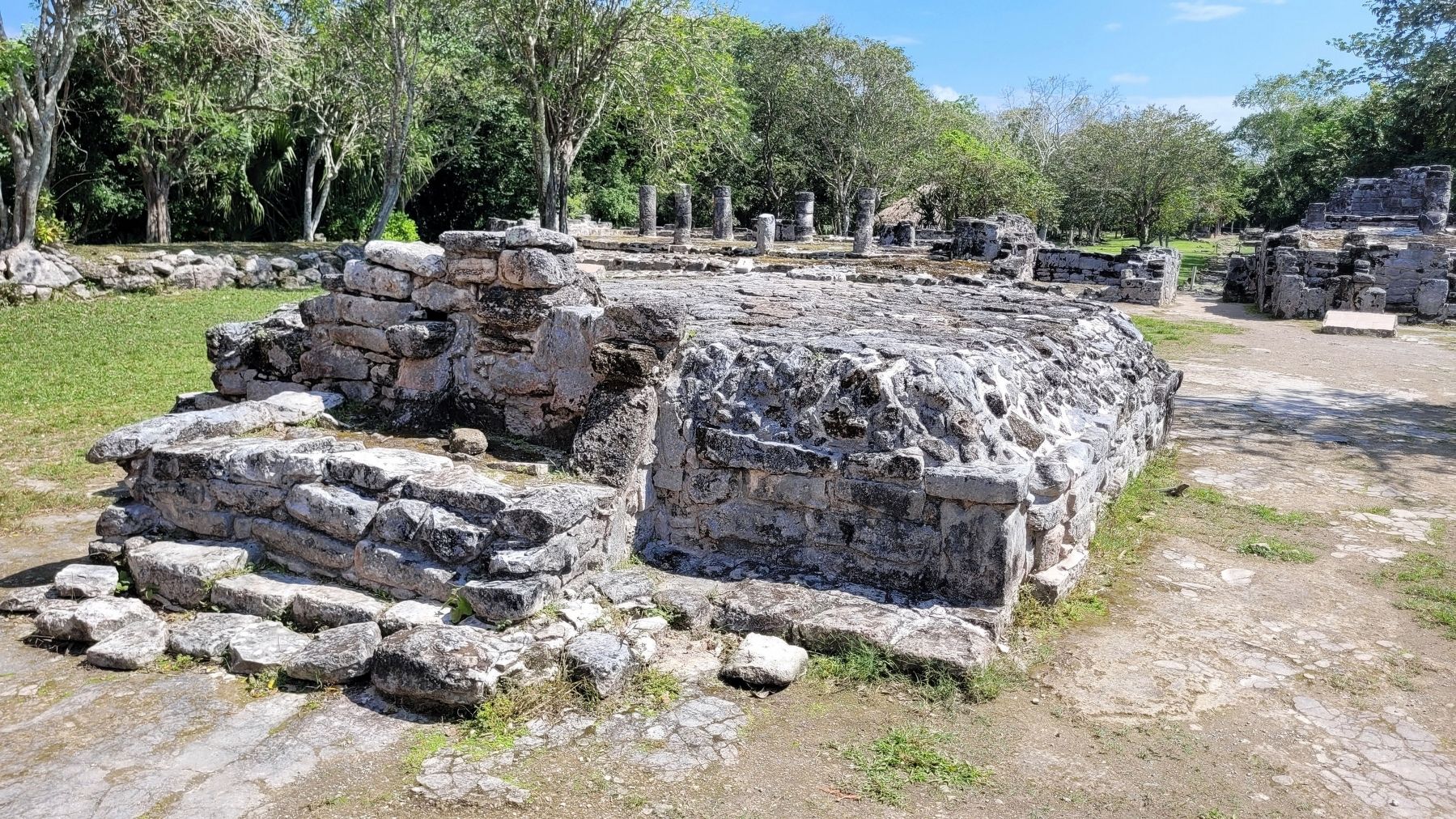Near San Miguel de Cozumel in Cozumel, Quintana Roo, Mexico — The Yucatan Peninsula (The Southeast)
Estructura El Altar / The Altar Structure
Esta estructura tuvo una función ceremonial; por su localización en medio de la plaza debió de servir como una especie de estrado, desde el cual una persona se dirigia a la gente congregada en el lugar. En "El Altar" podemos apreciar dos épocas constructivas: en el lado oeste hay una escalinata con alfardas, completamente recubierta de estuco, que es la más antigua y fue fechada para el periodo Clásico Terminal (1000-1200 d.C.); la estructura más tardia, que cubre a la primera, corresponde al Posclásico (1200-1650 d.C.).
Mayan:
Pakil Le Teemo Wa El Altar
Le pak ila meyajnaj tia'al k'ulintaj: yo'olal u yanil tu chúumuk le k'iiwiko mii meyajnaj je ex ka anal pak tu'ux ku kutal ajawo ob u yilo'ob waa ba'al ku yuuchule, kitak tu'ux ku wa'atal maak taan yeetel le maako ob ku much talo obi'. Ti "Te teemo ku paajtal k ilik ka'ap'éel k'iinil u betpajal: tu tséelil chik'ine' yaan jump'éel chan eeb yéetel polok che'ob, tulaakal bak pachta'an yéetel chichkuna'an luuk, leti u maas úuchbenil yeetel jts'a'ab u k'iin 1200 ts'o'okol ki'ichkelem yuum) yéetel tu yichilile' u kuuchil u k'ulintaj. "Mejen kabo obe" yaan ulaak ka'ap'éel k'iinil u betpajlil, tu ka'ap'éelile'k'iimbesa'an tu k'iinil Posclásico (1200- 1650 ts'o'okol ki'ichkelem yuum).
The Altar Structure
This structure had a ceremonial use as it lies in the middle of the plaza, and therefore it must have served as a dais from which the speaker addressed the people gathered here. In 'The Altar" one can observe two different construction periods: to the west there are balustraded steps, completely covered with stucco, which is the oldest construction and dates to the Terminal Classic period (1000-1200 A.D.); the latest structure, which covers the first one, belongs to the Post Classic period (1200-1650 A.D.).
Erected by Instituto Nacional de Antropología e Historia (INAH).
Topics. This historical marker is listed in these topic lists: Anthropology & Archaeology • Architecture • Native Americans. A significant historical year for this entry is 1200.
Location. 20° 30.005′ N, 86° 50.781′ W. Marker is near San Miguel de Cozumel, Quintana Roo, in Cozumel. Marker can be reached from San Gabriel Road, 6 kilometers east of Tran. de Comuzel. The marker is located at the southern section of the Zona Arqueológica San Gervasio. Touch for map. Marker is in this post office area: San Miguel de Cozumel QR 77684, Mexico. Touch for directions.
Other nearby markers. At least 8 other markers are within walking distance of this marker. Estructura El Alamo / The Alamo Structure (a few steps from this marker); Estructura Los Nichos / The Niches Structure (a few steps from this marker); Estructura Los Murales / The Murals Structure (a few steps from this marker); Estructura Las Columnas / The Columns Structure (a few steps from this marker); Estructura 25 B / Structure 25 B (a few steps from this marker); Estructura El Osario / The Ossuary Structure (a few steps from this marker); Estructura El Palacio / The Palace Structure (within shouting distance of this marker); Estructura El Arco / The Arch Structure (about 90 meters away, measured in a direct line). Touch for a list and map of all markers in San Miguel de Cozumel.
Also see . . . San Gervasio (Maya site). Wikipedia
San Gervasio is an archaeological site of the pre-Columbian Maya civilization, located in the northern third of the island of Cozumel off the northeastern coast of the Yucatán Peninsula, in what is now the Mexican state of Quintana Roo. San Gervasio's pre-Hispanic name was Tantun Cuzamil, Mayan for Flat Rock in the place of the Swallows. The ruins were once a hub of worship of the goddess Ix Chel, an aged deity of childbirth, fertility, medicine, and weaving. Pre-Columbian Maya women would try to travel to San Gervasio and make offerings at least once in their lives.(Submitted on July 8, 2023, by James Hulse of Medina, Texas.)
Credits. This page was last revised on July 12, 2023. It was originally submitted on July 7, 2023, by James Hulse of Medina, Texas. This page has been viewed 36 times since then and 8 times this year. Photos: 1, 2, 3, 4. submitted on July 8, 2023, by James Hulse of Medina, Texas.



